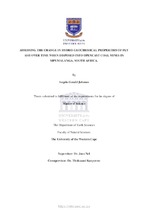| dc.description.abstract | Eskom supplies to 95% of South Africa’s energy needs and it primarily comes from coal combustion at their coal–fired power stations. Large volumes of fly ash are generated at these coal-fired power stations as a by-product of the coal combustion process. Fly ash is disposed onto landfills at the respective power stations and these landfills are currently running out of storage space. Subsequently, there are concerning environmental impacts upon the natural water environment resulting from coal mining. More specifically, the discharge of acid mine (AMD) water from historical coal mines impact negatively on the water quality in the nearby rivers and dams in the Witbank area.
Therefore, as a consequence of the limited space at fly ash landfills, Eskom has embarked on finding alternative ways to re-use fly ash in different applications such as: soil amelioration and land reclamation, road construction as well as brick and cement development. This study focussed on the feasibility of disposing fly ash into the backfill of historical and future coal mines with the intention to firstly reduce fly ash disposal at existing landfills and secondly to improve the decant water quality of the coal mines in the Witbank area.
Globally, fly ash has been successfully used in mine backfilling and AMD treatment in countries such as United States of America and India, due to cementitious properties of their fly ash. However, there is limited knowledge on how South African fly ash would behave under backfilled conditions of opencast coal mines where it will be exposed to acidic water environments. This is due to the fact that South African fly ash is considered a Level 3 type hazardous waste, due to its heavy metal concentrations. This waste classification is unique and the strictest compared to global classifications and these methodologies specify that fly ash should be disposed onto lined waste disposal sites due to the potential leaching of heavy metals from these waste sites. It is important to understand the hydrogeological and hydro-geochemical properties of fly ash over time once it is exposed to acid mine water.
Field and laboratory tests were conducted to understand these hydrogeological and hydro-geochemical properties of fly ash. Falling head hydraulic tests were conducted at two existing ash landfill sites to determine the hydraulic conductivity (K) of ash of different age. The results exhibit a decreasing trend in K with increasing age. This is due to the pozzolanic nature of fly ash and secondary mineralization of gypsum which causes the fly ash to harden in the presence of water from irrigation for dust suppression together with precipitation over time.
Laboratory testing included the use of constant head Darcy column tests to determine the change in K and geochemical properties of the leachate over time. Natural AMD with a pH of 2.5 and a metal composition was used as influent and the leachate were routinely collected and analysed for metal concentrations. The hydraulic conductivity of the fly ash showed a decreasing trend over time. During the placement of coal ash, the moisture allows pozzolanic reactions to solidify the coal ash and lowers the K, towards 10-1 m/d, relative to fresh ash. Secondary mineralization of calcium minerals, in the coal ash contributes to a further decrease in the K, by another order of magnitude from 10-1 m/d towards 10-2 m/d. Sulphate and iron minerals from the AMD also played a major role in the decreasing K as they accumulate in void spaces and having a clogging effect, decreasing the K to 10-3 m/d. The alkaline nature of the coal ash initially neutralizes the acidic levels of AMD from an inflow pH = 2.5 to an outflow pH = 11. Acidification of the outflow towards a pH = 4 was observed, due to large volumes of AMD (>80 000 mL) flowing through short coal ash columns. The K decreased to 3 orders of magnitude, from an initial 10-1 m/d to 10-3 m/d, with the AMD iron (>150 mg/L) and sulphate concentration (>2000 mg/L) playing the dominant role in reducing the hydraulic conductivity.
From the geochemical leach test results, it was observed that most of the leachate water was of a better quality than the influent AMD water quality. The outflow pH (pH = 11 to pH = 4) was higher than the pH of the inflow AMD (pH = 2.5). Overall EC reduced in discharge compared to inflow AMD (ECinflow: 535 – 545 mS/m versus ECoutflow: 350 – 490 mS/m), although Na and K in the leachate exhibited higher concentrations (10+2 mg/L) compared to the AMD inflow concentrations (10+1 mg/L). However, most of the other chemical elemental concentrations such as Fe (10-2 – 10+1 mg/L), Si (10-2 – 100 mg/L), Al (10-2 – 10+1 mg/L), Mn (10-2 – 10+1 mg/L), Cr (10-3 – 100 g/L) and SO4 (10+2 – 1+3 mg/L) in the discharge showed lower concentrations when compared to the inflow Fe (10+2 mg/L), Si (100 mg/L), Al (10+1 mg/L), Mn (10+1 mg/L), Cr (10-2 mg/L) and SO4 (10+3 mg/L) concentrations. These results show how fly ash backfill may impact on the current coal mining environment.
Overall, the laboratory hydraulic conductivity and geochemical testing showed promising results for fly ash backfilling. Based on this research, fly ash can be used to alter the existing coal mining environment as it is currently known in the Witbank area. The topography, hydraulic conductivity and the water table within the backfill can be altered to improve decant water quality of ash backfilled coal mines. | en_US |

